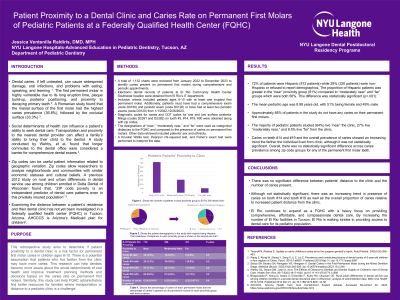Caries
Patient Proximity to a Dental Clinic and Caries Rate
258 - Patient Proximity to a Dental Clinic and Caries Rate on Permanent First Molars of Pediatric Patients at a Federally Qualified Health Center (FQHC)


Jessica Ventenilla Raldiris, DMD, MPH
Pediatric Dental Resident
NYU Langone, Tucson, AZ
NYU Langone, Tucson, AZ
Tucson, Arizona, United States- LH
Lauren Hobeich, DDS
NYU Langone Tucson, AZ
Tucson, Arizona, United States - DK
Daniel J. Kane, DMD
Program Director
NYU Langone Health
Brooklyn, New York, United States
Presenting Author(s)
Research Mentor(s)
Program Director(s)
Purpose: This retrospective chart review aims to determine if patient proximity to a dental clinic is a risk factor for caries on permanent first molars in children.
Methods: Electronic dental records of patients ages 8-10 with at least one erupted first permanent molar were reviewed from 1/1/2022 to 12/26/2023. Additionally, patients must have had a comprehensive exam and periodic exam or have had at least two periodic exams during the study interval. Diagnostic codes for caries and CDT codes for one and two surface fillings on permanent first molars were obtained along with zip codes. The designations of “near,” “moderately near,” and “far” were used as categorical distances to the FQHC and compared to the presence of caries.
Results: A review of 1,132 pediatric charts (2022-2023) found that 85% of patients had no caries on permanent first molars. Most patients (64%) lived "near" the clinic. Hispanic patients were more concentrated in the "near" group (81%) compared to other groups (56%). While there was an increasing trend in caries prevalence with distance from the clinic, it was not statistically significant, and no significant differences were found in caries rates across zip code groups.
Conclusions: There was no significant difference between patients’ distance to the clinic and the number of caries present. Nevertheless, there was a slight increasing trend in tooth #14, #19, and the overall proportion of caries. These findings, though not statistically significant, suggest further studies on social determinants of health affecting caries in pediatric patients.

.jpg)